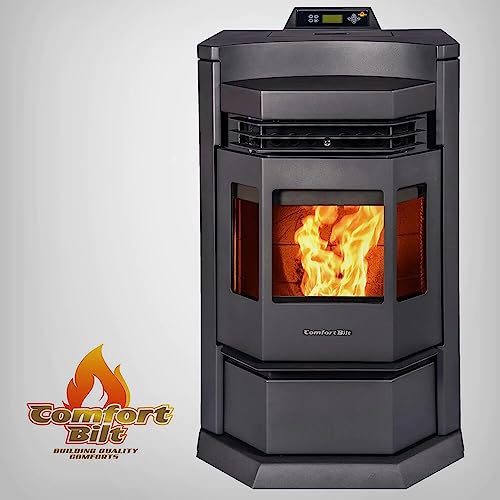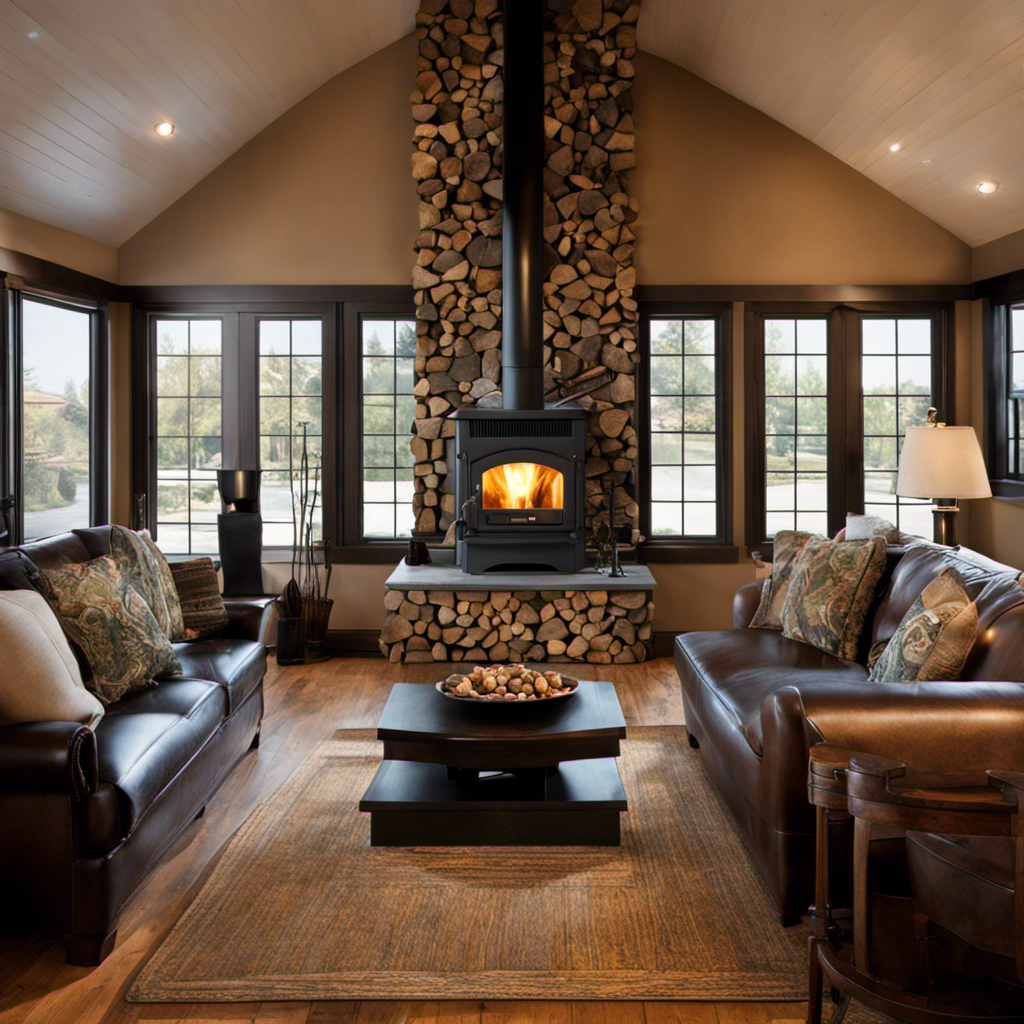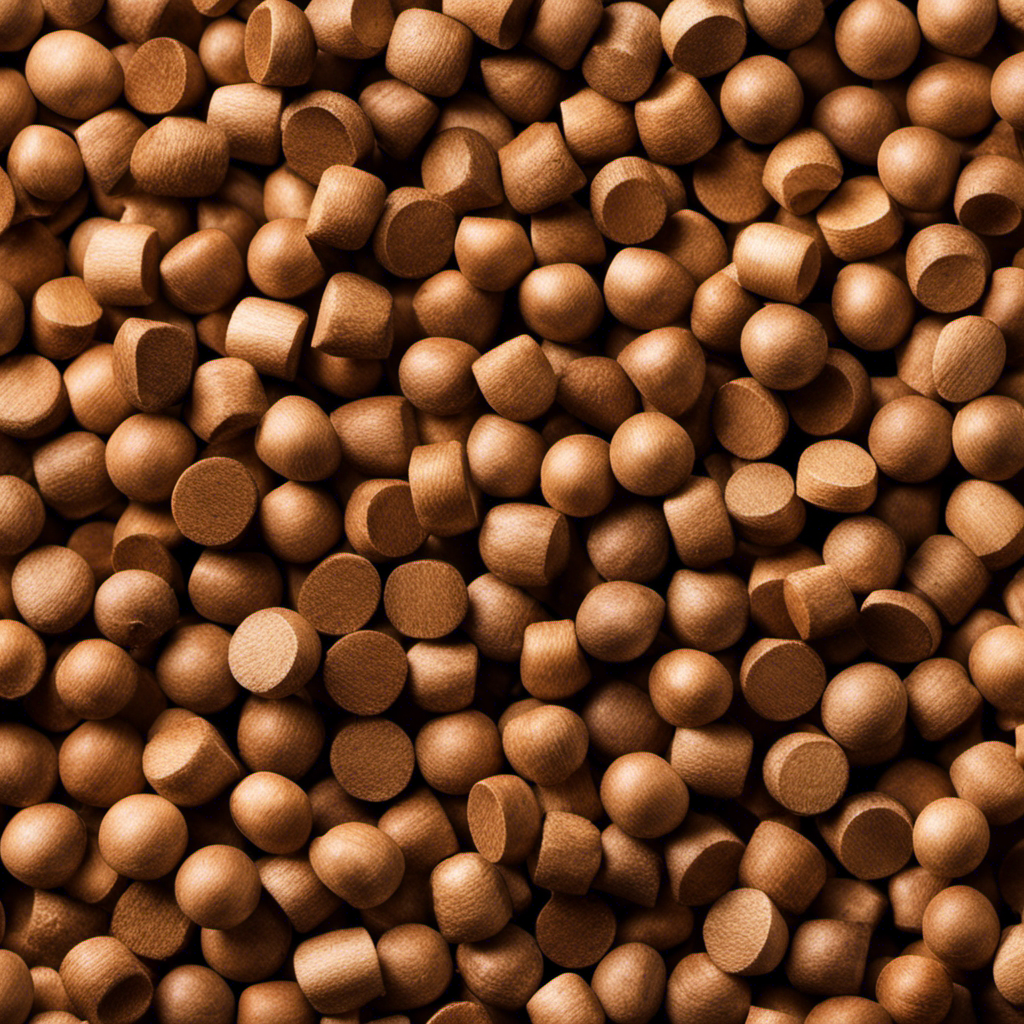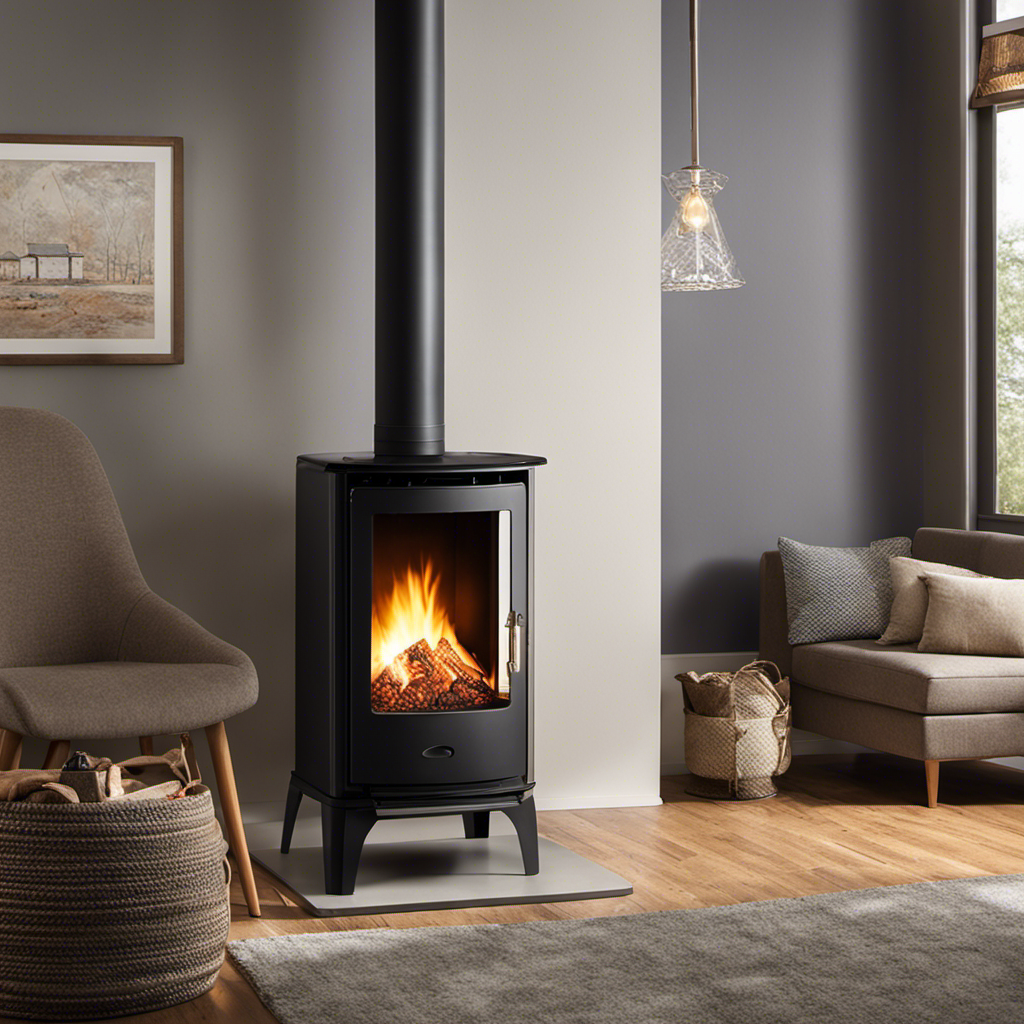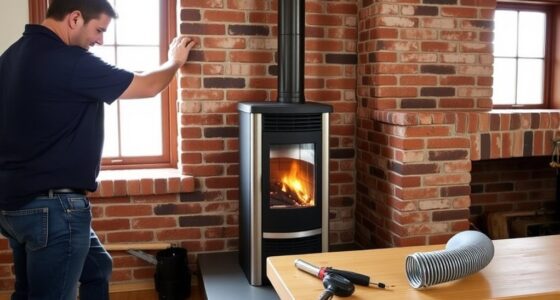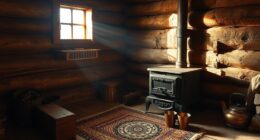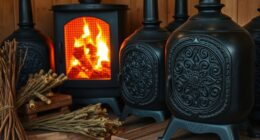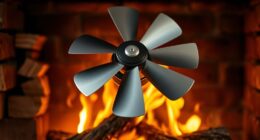Every time I use my pellet stove at home, I can’t help but detect a potent wood aroma. This puzzling situation is something I think many homeowners can empathize with.
In this article, we will explore the potential causes behind this wood smell and provide valuable insights into understanding the operation of pellet stoves.
Additionally, we’ll discuss proper maintenance techniques and common ventilation issues that may contribute to this problem.
Stay tuned for helpful tips on reducing wood smell and knowing when it’s time to seek professional assistance.
Key Takeaways
- Debris or ash buildup around the stove can cause wood smell in the house.
- Understanding the operation of pellet stoves and proper ventilation is important to address the issue.
- Regular cleaning and maintenance of key components such as the burn pot and chimney can eliminate wood odor.
- Cleaning the vents and inspecting the pellet hopper are essential for proper airflow and pellet feeding, ensuring optimal performance and reducing wood smell.
Potential Causes of Wood Smell in the House
You might be wondering what could be causing the wood smell in your house when your pellet stove is burning. There are a few potential causes of this odor that you can consider.
First, it’s important to check if there is any debris or ash buildup around the stove. This can create a burnt wood smell that spreads throughout the house.
Another possible cause could be that the pellets themselves have a strong scent when burned. Some brands may have additives or a higher moisture content, which can result in an intense wood smell.
To eliminate the wood odor, make sure to regularly clean and maintain your pellet stove, including removing any built-up debris and using high-quality pellets with low moisture content.
Understanding pellet stove operation will further help you address this issue without much hassle.
Understanding Pellet Stove Operation
When operating a pellet stove, it’s important to understand how it functions. A pellet stove is an efficient and eco-friendly heating appliance that burns compressed pellets made of wood or other biomass materials. To help you better understand its operation, here’s a table outlining the key components and their functions:
| Component | Function |
|---|---|
| Hopper | Stores the pellets for combustion |
| Auger | Transports the pellets to the burn pot |
| Burn Pot | Holds and ignites the pellets |
| Combustion Fan | Provides air for combustion process |
| Exhaust Fan | Removes waste gases from the stove |
Troubleshooting common issues with pellet stoves can help ensure optimal performance. Some problems include poor flame quality, frequent shutdowns, or excessive ash buildup. Regular maintenance, such as cleaning the burn pot and chimney, can also prevent these issues.
Proper maintenance for pellet stove efficiency includes regular cleaning, inspecting and replacing gaskets if necessary, checking electrical connections, and ensuring proper ventilation. By following these guidelines, you can keep your pellet stove running smoothly and enjoy its many benefits.
Proper Maintenance for Pellet Stove Efficiency
When it comes to maintaining the efficiency of a pellet stove, there are two key points to focus on: cleaning the vents and regularly inspecting the pellet hopper.
Cleaning the vents is important as it ensures proper airflow and prevents any blockages that could reduce heating efficiency.
Regularly inspecting the pellet hopper allows you to check for any signs of wear or damage. This ensures that pellets can be stored properly and fed into the stove without any issues.
Cleaning Pellet Stove Vents
To prevent potential hazards, it is important to regularly clean the vents of your pellet stove when it’s burning wood smell in the house. This is essential for maintaining its efficiency and preventing any issues related to a strong wood smell. Here are four important steps to follow:
- Turn off the pellet stove and allow it to cool down completely before starting the cleaning process.
- Use a soft brush or vacuum cleaner to remove any dust or debris from the vent openings.
- Check for any obstructions or blockages in the vents and clear them if necessary.
- Wipe down the exterior of the vents with a damp cloth to remove any buildup.
By regularly cleaning your pellet stove vents, you can ensure proper airflow and minimize any unpleasant smells caused by burning wood.
Now let’s move on to regularly inspecting the pellet hopper for optimal performance without compromising safety.
Regularly Inspecting Pellet Hopper
Regularly inspect the pellet hopper to ensure optimal performance and safety. A properly functioning pellet hopper is crucial for efficient burning and minimizing the wood smell in your house when the pellet stove is operating.
Begin by visually examining the hopper for any signs of damage or blockage. Clear out any debris or ash that may be obstructing the flow of pellets into the stove.
Next, check that the auger is turning smoothly and delivering a consistent amount of pellets. If you notice any issues during your inspection, such as a clogged auger or a malfunctioning motor, it’s important to address them promptly to prevent further problems with your pellet stove’s ventilation system.
Speaking of ventilation, let’s now turn our attention to common issues with pellet stove ventilation…
Common Issues With Pellet Stove Ventilation
If your wood smell is lingering in the house, you might want to check for common issues with your pellet stove ventilation. Proper ventilation is crucial for a pellet stove to function efficiently and prevent any odors from spreading throughout your home.
One common issue could be a blocked or clogged vent pipe. Check for any obstructions such as bird nests or debris that may be restricting airflow. Another potential problem could be a malfunctioning exhaust fan, which can lead to poor ventilation and the accumulation of smoke and odor inside your house. Additionally, make sure that the vent pipe is properly installed and sealed to prevent any leaks or backdrafts.
By addressing these ventilation troubleshooting steps, you can effectively reduce the wood smell in your house without resorting to drastic measures or expensive solutions.
Now let’s move on to some tips for reducing wood smell in the house…
Tips for Reducing Wood Smell in the House
When it comes to reducing wood smell in the house, there are two key points to consider: odor-absorbing techniques and proper ventilation methods.
Odor-absorbing techniques can help to neutralize and eliminate the lingering wood smell, while proper ventilation methods ensure that fresh air is continuously circulated throughout the house.
Odor-Absorbing Techniques
To combat the strong odors caused by wood smoke, try using activated charcoal or baking soda in your home. These odor-absorbing products can help neutralize the smell and improve the air quality.
Here are four natural remedies that you can use to tackle the wood scent:
-
Activated Charcoal: Place small bowls filled with activated charcoal around your house to absorb odors.
-
Baking Soda: Sprinkle baking soda on carpets, upholstery, and other surfaces affected by the smell, then vacuum it up after a few hours.
-
Essential Oils: Add a few drops of essential oils like lavender or lemon to a spray bottle filled with water and spritz it around your home to freshen up the air.
-
Fresh Air: Open windows and doors regularly to let in fresh air and allow proper ventilation.
By incorporating these odor-absorbing techniques into your routine, you can effectively reduce wood smells in your home.
Now let’s move on to discussing proper ventilation methods for better air circulation without compromising comfort.
Proper Ventilation Methods
Don’t forget to regularly open your windows and doors to allow fresh air to circulate throughout your home. Proper ventilation is essential for improving air quality and reducing any lingering wood smell in your house, especially when you have a pellet stove burning.
Ventilation techniques can help remove indoor pollutants and bring in clean outdoor air. One effective method is cross-ventilation, where you open windows or doors on opposite sides of the house to create a natural flow of air. Additionally, using exhaust fans in kitchens and bathrooms can help remove odors and moisture from the air.
By implementing these ventilation techniques, you can significantly improve the overall air quality in your home.
When it comes to dealing with wood smell issues that persist despite proper ventilation methods, seeking professional help may be necessary.
When to Seek Professional Help for Wood Smell Issues
If you’re experiencing a persistent wood smell in your house while your pellet stove is burning, it may be time to consider seeking professional help.
There can be several causes of this wood odor issue. One possible cause is the accumulation of creosote in the chimney or flue system, which can result from incomplete combustion. Another potential cause could be a malfunctioning or poorly installed stove, leading to improper ventilation and the release of unburned particles into your living space. In some cases, mold growth on nearby surfaces can also contribute to the wood smell.
To eliminate this unpleasant odor, it’s important to address the root cause. Seeking professional help is recommended as they have the expertise to identify and resolve these issues effectively and safely.
Frequently Asked Questions
How Can I Tell if the Wood Smell in My House Is Coming From the Pellet Stove?
I can determine if the wood smell in my house is from the pellet stove by checking for any visible signs of smoke or ash, and by inspecting the stove for leaks or malfunctions.
Can Using a Different Type of Wood Pellets Reduce the Wood Smell in My House?
Using different types of wood pellets can potentially reduce the wood smell in your house. However, the effectiveness may vary. Consider using air purifiers as well to further minimize any lingering odors.
Is It Normal for a Pellet Stove to Emit a Wood Smell During Operation?
Yes, it is normal for a pellet stove to emit a wood smell during operation. To prevent this, you can try using different types of wood pellets or ensuring proper ventilation in your house.
Are There Any Specific Household Products or Remedies That Can Help Eliminate Wood Smell in the House?
I’ve found that using household products like baking soda, vinegar, or air fresheners can help eliminate wood smell in the house. These remedies are effective for odor control and freshening up the space.
Can Improper Installation of a Pellet Stove Cause Wood Smell Issues in the House?
Improper installation of a pellet stove can cause wood smell issues in the house. It is essential to ensure proper ventilation, sealing, and maintenance to prevent wood smell from spreading throughout the house.
Conclusion
In conclusion, it’s important to address the issue of wood smell in your house when your pellet stove is burning.
By understanding the potential causes of this odor and properly maintaining your pellet stove, you can ensure its efficiency and reduce any unpleasant smells.
Additionally, paying attention to ventilation issues and implementing tips for minimizing wood smell can greatly improve the air quality in your home.
If these measures do not resolve the problem, it may be necessary to seek professional help to identify and address any underlying issues causing the wood smell.
Logan’s affair with adventure began in childhood. He hailed from a small town where vast forests bordered one side and endless shores stretched on the other. His days were spent exploring uncharted woods, climbing tall trees, or listening to the tales of old sailors. This early immersion in a world brimming with stories and mysteries became the foundation of his passion for writing.



